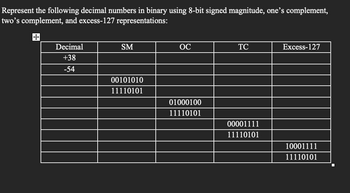

Signed Magnitude:
When a number is expressed in sign-magnitude form, the MSB is used to indicate the number's sign, while the remaining bits reflect its magnitude. Therefore, simply add the sign bit to the leftmost side of an unsigned binary number. This representation is comparable to that of signed decimal numbers.
1's complement:
By complementing each bit in a signed binary number, one can derive the 1's complement of a given number. Therefore, a positive number multiplied by one produces a negative number. The complement of a negative number, 1, yields a positive number. The original signed binary number can be obtained by doing two times the 1's complement of a binary number that includes the sign bit.
2's complement:
One is added to the 1's complement of a signed binary number to produce the binary number's 2's complement. The result is a negative number when a positive number is multiplied by two. Similar to this, adding two to a negative number results in a positive number. The original signed binary number can be obtained by performing two times the 2's complement of a binary number that includes the sign bit.
Excess 127:
The excess-M form of a signed integer yields the unsigned binary value by simply adding M to the signed integer. – The number 010, for instance, is represented as 0 + 7 = 710 = 01112, assuming that we're using excess-7 representation. – The symbol for the number 310 is 3 + 7 (1010 = 10102).
Using the above procedure we can calculate each field in the table...
Step by stepSolved in 2 steps

- Represent the following decimal numbers in binary using 8-bit signed magnitude, one's complement, and two's complement representations: a) 59 b) -59arrow_forwardConvert the following 12 bits 2’s complement number to decimal number 1111 1100 01112c12arrow_forwardonvert the following decimal numbers to binary using the two’s complement format, using 8 bits: 4810 -3910 -28410 010arrow_forward
- Convert the following numbers from binary to decimal, assuming 6-bit two's complement binary representation: a) 101011 b) 011101 c) 111111 IIIarrow_forwardConvert the following binary numbers to decimal numbers.(a) 1011(b) 11011010(c) 01001011(d) 10110100arrow_forwardConvert the decimal number -3 into an 8-bit 2’s complement binary number.arrow_forward
- Convert the following two’s complement binary fixed-point numbers to base 10. The implied binary point is explicitly shown to aid in your interpretation. 011110.10101 100110.10110arrow_forwardConvert the following two’s complement binary fixed-point numbers to base 10. The implied binary point is explicitly shown to aid in your interpretation. 0110.1011 1111.1111arrow_forwardRepresent the decimal number 44 in binary using 8-bit two's complement O 00101100 00111100 O 00101101 O 00101111arrow_forward
- What are the 16-bit 1’s and 2’s complements of the following binarynumbers? Number is - 0100111000100100arrow_forwardAdd the following signed 5-bit 2's complement binary numbers and convert the sum to a decimal (bose ten) numbe a) e0111 + 00011 this sum in base ten: b) 11101 + 00011 this sum in base ten: c) 10001 + 10001 this sum in base ten: d) 10000 + 100ee this sum in base ten: e) 10101 + 01010 this sum in base ten: LLLarrow_forwardFind the binary representation for each of the following decimal represented numbers: 4, 8, 16, 32arrow_forward
 Computer Networking: A Top-Down Approach (7th Edi...Computer EngineeringISBN:9780133594140Author:James Kurose, Keith RossPublisher:PEARSON
Computer Networking: A Top-Down Approach (7th Edi...Computer EngineeringISBN:9780133594140Author:James Kurose, Keith RossPublisher:PEARSON Computer Organization and Design MIPS Edition, Fi...Computer EngineeringISBN:9780124077263Author:David A. Patterson, John L. HennessyPublisher:Elsevier Science
Computer Organization and Design MIPS Edition, Fi...Computer EngineeringISBN:9780124077263Author:David A. Patterson, John L. HennessyPublisher:Elsevier Science Network+ Guide to Networks (MindTap Course List)Computer EngineeringISBN:9781337569330Author:Jill West, Tamara Dean, Jean AndrewsPublisher:Cengage Learning
Network+ Guide to Networks (MindTap Course List)Computer EngineeringISBN:9781337569330Author:Jill West, Tamara Dean, Jean AndrewsPublisher:Cengage Learning Concepts of Database ManagementComputer EngineeringISBN:9781337093422Author:Joy L. Starks, Philip J. Pratt, Mary Z. LastPublisher:Cengage Learning
Concepts of Database ManagementComputer EngineeringISBN:9781337093422Author:Joy L. Starks, Philip J. Pratt, Mary Z. LastPublisher:Cengage Learning Prelude to ProgrammingComputer EngineeringISBN:9780133750423Author:VENIT, StewartPublisher:Pearson Education
Prelude to ProgrammingComputer EngineeringISBN:9780133750423Author:VENIT, StewartPublisher:Pearson Education Sc Business Data Communications and Networking, T...Computer EngineeringISBN:9781119368830Author:FITZGERALDPublisher:WILEY
Sc Business Data Communications and Networking, T...Computer EngineeringISBN:9781119368830Author:FITZGERALDPublisher:WILEY





